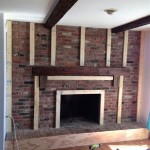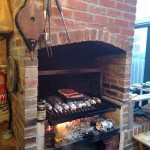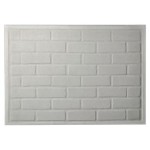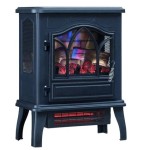Do You Have To Have a Mantle On a Fireplace?
The presence of a mantel above a fireplace is a common design element in many homes, often serving as a focal point in a living room or family space. However, the question of whether a mantel is a mandatory component of a fireplace setup is not straightforward and depends on a variety of factors, including the type of fireplace, local building codes, and personal aesthetic preferences. This article aims to explore the necessity of a fireplace mantel, examining the practical considerations, safety aspects, and design implications that influence its inclusion or exclusion.
A fireplace mantel, traditionally a shelf or framing structure positioned above the fireplace opening, has historically served a dual purpose: both functional and decorative. Functionally, it provided a place to set items, such as clocks, pictures, or decorative objects, and even served as a barrier to shield the wall above the fireplace from heat. Decoratively, it offered an opportunity to enhance the aesthetic appeal of the fireplace and the surrounding room, often crafted from materials like wood, stone, or metal, and designed in various styles to complement the overall interior design.
Before delving into the specific scenarios where a mantel might or might not be required, it is crucial to understand the different types of fireplaces that exist. These include traditional wood-burning fireplaces, gas fireplaces, electric fireplaces, and even newer ventless or ethanol fireplaces. Each type operates differently and generates varying levels of heat, which directly impacts the need for protective measures like a mantel.
Safety Regulations and Building Codes
One of the primary factors determining the necessity of a mantel is the adherence to safety regulations and local building codes. These codes are designed to ensure the safe operation of fireplaces and prevent fire hazards. In many jurisdictions, building codes specify minimum clearances between the fireplace opening and any combustible materials, including the wall directly above the fireplace. This clearance is intended to prevent the wall from overheating and potentially igniting.
A mantel can play a significant role in meeting these safety requirements. By projecting outward from the wall, a mantel can act as a heat shield, deflecting heat away from the combustible wall surface. This projection can effectively increase the distance between the heat source and the wall, reducing the risk of fire. The specific dimensions of the mantel's projection and height above the fireplace opening are often dictated by local building codes and are dependent on the type of fireplace and its heat output.
It is advisable to consult with a qualified building inspector or fireplace professional to determine the specific code requirements in your area. These professionals can assess the installation and advise on whether a mantel is necessary to meet safety standards. Failure to comply with building codes can result in fines, mandatory modifications, and, more importantly, increased fire risk.
In cases where a fireplace is installed without a mantel, and the wall material above the fireplace is combustible, the installation should still meet the required minimum clearances. This might involve using non-combustible materials for the wall surface or incorporating other heat-shielding techniques to protect the combustible elements. The exact methods for achieving compliance will vary depending on the specific regulations and the characteristics of the fireplace and surrounding structure.
Type of Fireplace and Heat Output
The type of fireplace installed directly influences the necessity of a mantel. Traditional wood-burning fireplaces typically generate the highest levels of heat and therefore require more stringent safety measures. Gas fireplaces also produce significant heat, though generally less than wood-burning models. Electric fireplaces, on the other hand, generate minimal heat and often do not require a mantel for safety purposes, though one may still be desired for aesthetic reasons.
For wood-burning and gas fireplaces, the heat output is a crucial factor in determining mantel requirements. High-output fireplaces necessitate a more substantial mantel projection to adequately deflect heat. The material of the mantel itself also plays a role. Non-combustible materials like stone or metal offer greater heat resistance and may allow for a smaller mantel projection compared to wood.
Electric fireplaces, which often use electric resistance heating or simulate flames with LED lights, generally do not produce enough heat to pose a fire risk to the surrounding wall. Therefore, a mantel is typically not required for safety. However, many homeowners choose to install a mantel above an electric fireplace to achieve a more traditional fireplace appearance and to provide a surface for decorative items.
Ventless or ethanol fireplaces offer a unique scenario. While they do produce real flames, they are designed to burn cleanly and efficiently, often generating less heat than traditional fireplaces. The manufacturer's guidelines for these fireplaces should be consulted to determine if a mantel is necessary. Some models may require a small, non-combustible mantel or heat shield, while others may not necessitate any additional protection.
Design Considerations and Aesthetic Preferences
Beyond safety and building code requirements, design considerations and personal aesthetic preferences significantly influence the decision to include a mantel. A mantel can serve as a central design element in a room, adding character, style, and a focal point. The choice of material, design, and size of the mantel can dramatically impact the overall aesthetic of the fireplace and the surrounding room.
A mantel can be crafted from a variety of materials, each offering a distinct look and feel. Wood mantels, available in different types of wood and finishes, provide a warm and traditional aesthetic. Stone mantels, made from materials like marble, granite, or limestone, offer a more elegant and sophisticated look. Metal mantels, constructed from materials like steel or cast iron, provide a modern and industrial feel. The choice of material should complement the overall design scheme of the room and the style of the fireplace.
The design of the mantel can also vary widely, from simple and minimalist designs to ornate and elaborate styles. A simple mantel can provide a clean and modern look, while an ornate mantel can add a touch of grandeur and sophistication. The size of the mantel should be proportionate to the size of the fireplace and the room. A mantel that is too large or too small can disrupt the visual balance of the space.
Even in situations where a mantel is not strictly required for safety reasons, such as with electric fireplaces, homeowners may choose to install one solely for aesthetic purposes. A mantel can provide a platform for displaying artwork, photographs, or other decorative items, enhancing the visual appeal of the fireplace and the room. It can also serve as a unifying element, tying together the fireplace with the surrounding décor.
In contemporary designs, the absence of a traditional mantel is becoming increasingly common. Some homeowners prefer a minimalist aesthetic, opting for a clean, unadorned fireplace surround without a projecting mantel. This can be achieved by using non-combustible materials for the entire fireplace surround, allowing the wall itself to act as the visual focal point. Alternatively, some designs incorporate a shallow shelf or ledge instead of a traditional mantel, providing a subtle surface for display without significantly projecting into the room.
Ultimately, the decision of whether to include a mantel on a fireplace involves a careful consideration of safety regulations, the type of fireplace, and personal design preferences. While a mantel is often required for safety purposes with wood-burning and gas fireplaces, it may not be necessary with electric and ventless models. In all cases, it is essential to consult with a qualified building inspector or fireplace professional to ensure compliance with local building codes and to ensure the safe operation of the fireplace.

How To Select And Size Your Fireplace Mantel Water S Edge Woods Custom Wood

How To Select And Size Your Fireplace Mantel Water S Edge Woods Custom Wood

How To Install A Floating Mantle The Easy Way In Just One Afternoon

Fireplace Mantle Nice And Simple Life Of An Architect

Mantel And Hearth Considerations For Your Fireplace We Love Fire

How To Install A Mantel On Brick Fireplace 1905 Farmhouse

Fireplace Mantel Wikipedia

How To Install A Mantel On Brick Fireplace 1905 Farmhouse

Fireplace Mantels Installation Care Redwood Burl Inc

Fall Decor Design Ideas Fireplace Mantel Greenhouse Studio
Related Posts








